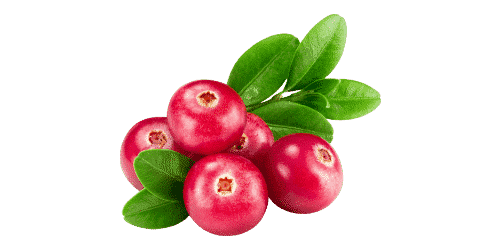
Origin
Cranberry, also known as “American cranberry”, originated in the northern United States and Canada. At the time, American Indians used cranberries to prevent infections from wounds and inflammation.1
Did you know?
Americans and Canadians are big consumers of cranberries. It is consumed in the form of juices, dried fruit and sauces.
Characteristics
Very similar to the bilberry, the cranberry is a shrub measuring around 30 cm in height which grows very slowly. The plant has long periods of dormancy, regulated by drops in temperature and the number of hours of sunshine. It has dark green foliage and small pinkish white flowers. Gradually, the shrub begins to produce the fruit and greenish berries emerge which become red when ripe.
Flowering and harvesting
The cranberry is today cultivated in various regions of the north American continent. Flourishing in moist soils and in semi-shaded locations, it grows in bogs and highland forests. Its flowers usually appear at the end of June, providing a beautiful display of pinkish white blossom. Afterwards, the shrub bears its fruit, the red berries . They are harvested when they are ripe, in September. In phytotherapy, the berries are used as they naturally contain type-A proanthocyanidins.
Benefits
The berry contains various sugars, as well as organic acids, vitamin C, anthocyanosides and flavonoids.2
The cranberry:
- Promotes the healthy functioning of the urinary tract2
The cranberry can help to regulate various urinary disorders, promoting therefore the healthy functioning of the urinary tract.
- Helps to prevent urinary disorders2
Cranberry is recommended to prevent urinary tract disorders, especially when they are recurring problems.
1McCormack, M. et Latouf, J.B. (2002). Cranberries and the prevention of urinary infections: myth or reality? Le clinicien
2 Plant-based health: 200 plants with health benefits Reader’s Digest selection, 2003. 352 p. ISBN 2-7098-1413-7
